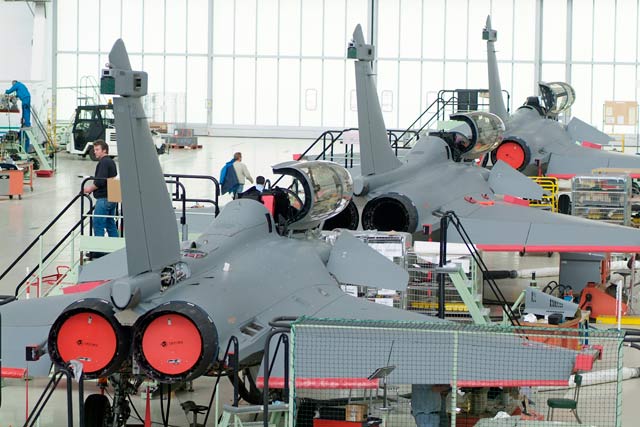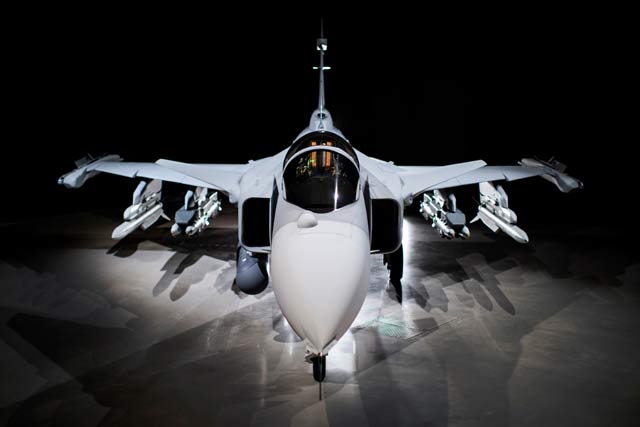The Indian air force continues to grapple with the challenge of sustaining its combat fleet to project a strong defensive and offensive posture on India’s eastern and western borders. Defence credibility, however, comes from the existing force structure. The air force today is down to 33 operational fighter squadrons, of which 24 squadrons are made up with fighters of Russian origin, namely MiG-21s, MiG-23s, MiG-27s, MiG-29s, and Sukhoi Su-30MKIs.
By 2024, the bulk of this fleet, 11 squadrons of obsolete MiG-21s and MiG-27s, will have retired on account of having completed their total technical life. In 2017 alone, two squadrons of MiG-21s and at least one of MiG-27s will go. Given these retirements, for the next decade, the air force will be lucky to retain – let alone surpass – its current strength of 33 combat squadrons
“We need numbers as we are not building force structures for Pakistan and the main concern is China,” says Air Marshal M Matheswaran, a retired deputy chief of integrated defence staff who has served in advisory roles to Hindustan Aeronautics and Reliance Industries. “India needs to build up her military capability.”
India’s ponderous defence bureaucracy and decision-averse politicians have finally woken up to the necessity of pushing the air force up to its authorised strength of 42.5 combat squadrons. But getting the force to this strength is not likely until 2035.
The purchase of 36 Dassault Rafale combat aircraft in September 2016 marked the end of India’s decade-long Medium Multi-Role Combat Aircraft acquisition saga. India will pay €7.75 billion ($8.2 million) for 36 Rafales, along with associated weapons and support packages. Rafale deliveries to India are to start in September 2019 and conclude in April 2022, allowing the air force to stand up two operational squadrons of the “swing role” type.
Each Rafale will cost India’s ministry of defence €91 million. Armament comes from MBDA: Meteor beyond-visual-range and MICA IR and RF air-to-air missiles, and SCALP cruise missiles.

Dassault has pledged to support India's future fighter operations over a 50-year period
Dassault
Commenting on the impact of the acquisition for the Indian air force, Teal Group analyst Richard Aboulafia says: “The Rafales will by a wide margin be India’s most capable and service-ready aircraft. The Su-30s are certainly capable, but reliability has been a big challenge, and they are quite expensive to operate. Overall, the Rafales are likely to be a more valuable asset.” Aboulafia pegs Rafale maintenance costs at around $15,000 per hour, including engines, etc.
The air force has also contracted for five years of performance-based logistics support with an option to extend support by a further seven years. Dassault will also provide product support for a period of 50 years. Under the terms of the inter-governmental agreement between India and France, there is no provision for any technology transfer, though Dassault Aviation must satisfy offset provisions for 50% of the value of the aircraft and weapons package.
“Offsets are extremely expensive,” says Aboulafia. “The buyer pays, not the seller. India needs intra-country competition if it wants to make offsets work.”
“India’s government needs to have a frank and open debate,” he adds. “Does it want weapons procurement of effective systems at a reasonable price, or want greater in-country capabilities and jobs? The two goals are not compatible.”
Apart from the Rafale deal, it emerged in 2016 that companies such as Lockheed Martin and Boeing had briefed Indian officials about producing types such as the single-engine F-16 and twin-engine F/A-18E/F Super Hornet in India. Defence minister Manohar Parrikar subsequently announced that New Delhi wants a single-engined fighter type under its “Make in India” initiative.
Early this year, Parrikar said his ministry was working on a strategic partnership model under which the new single-engined fighter jets would be acquired. The two firms competing for the potential contract are Swedish airframer Saab, with the Gripen, and Lockheed, with the F-16 Block 70. Both manufacturers mounted a major effort in the late 2000s as part of the MMRCA campaign, but were among the first aircraft eliminated.
The proposals from both companies emphasise technology transfer. Regarding acquisition numbers, Matheswaran reckons: “The IAF needs at least 200 MMRCA-class aircraft, whether it is one type or two types. The primary factor in selecting two types will be cost and technology. Cost will be a key aspect as is the technology access and how it will aid our defence aerospace industry.”
Lockheed made its pitch to the Indian Government in April 2016, offering to transfer the F-16 production line to India. Subsequently, Lockheed received a formal letter from New Delhi, expressing an interest in acquiring a single-engined fighter, to which it responded in October 2016.
“In our discussions neither we, nor the government of India have indicated a preference for an Indian production partner,” says Randy Howard, business development director for Lockheed’s integrated fighter group. “It is our understanding that the defence procurement policy is being revised with a strategic partnership view and it is also our understanding that New Delhi would like to encourage private industry.”
Saab, which has long hoped to sell the Gripen NG to India, says it has laid out comprehensive plans to support further design of the platform in India, in addition to creating the ecosystem for in-country manufacture and support for the platform. It is also willing to offer India comprehensive system and software control, in addition to information sharing and technology transfer related to active electronically scanned array (AESA) radars with gallium nitride technology. Saab has also offered to provide design consultancy for India’s troubled domestic fighter, the HAL LCA Mk-1A.
Both Lockheed and SAAB will have to navigate strict Indian requirements for access to key technologies, which could prove a stumbling block for an early conclusion to negotiations.
“India is one of the many places the Trump Administration is going to have to choose between priorities,” says Aboulafia. “If US companies agree to transfer the necessary work and technology to India, they will likely have a strong advantage.”
Aboulafia’s colleague at Teal, Joel Johnson, says both the Lockheed and Saab fighters are contingent on Washington DC’s approval, owing to the large number of systems and technologies in both the F-16 and Gripen that are covered by US International Traffic in Arms Regulations (ITAR).
“Saab will have to get US approval for the sale of Gripen to anyone, as it contains considerable US ITAR-controlled items, including the GE engines,” he says. “It would need US approval (and likely specific company approval depending on what rights the defence department has to the intellectual property involved) for the transfer of any US military technology on the plane.”
There are no doubts or restrictions on technology transfer, says Rob Hewson Vice President and Head of Communications Saab Asia Pacific. “Saab owns and controls all Gripen system software, and key mission systems such as the AESA radar, Infra-Red Search & Track (IRST), datalinks and Electronic Warfare (EW) system are not sourced from the US. Items that are produced in the US, such as the engine, have already been made available to India.”
The relaxation of strict export controls and the actual extent of technology transfer is an area that Indian negotiators are likely to push for. Another aspect that needs clarity is the extent to which the air force would be allowed to integrate their choice of weapon systems on the F-16 and Gripen. Hewson says that a fundamental element of the Gripen design philosophy and a key aspect of the new avionics architecture on Gripen E, was that it was designed for easy and affordable weapons integration. “IAF will be able to integrate existing and future weapons with Gripen quickly and at a manageable cost – this is not the case with most other modern fighters,” he asserts.

Saab is promoting the Gripen E for a competition to select new single-engined fighters
Saab
Meanwhile, Johnson is dubious about how far the government will go in allowing India to select its own weapons for the F-16. “The US government generally dislikes modifying US military aircraft to carry any foreign weapons systems, and protects source code on our military aircraft so other countries can’t do the integration themselves.”New Delhi also sees the joint development of the Fifth Generation Fighter Aircraft with Russia as another source of high-end know how.
With both MMRCA and FGFA, New Delhi bargained hard for technology transfer and succeeded in extracting favourable concessions, but neither deal panned out as expected. This year will mark a decade since the inking of the FFGA agreement between India and Russia.
“The conditions and contractual terms that we have discussed for FGFA are very beneficial for India,” says HAL chairman Suvarna Raju. “We are positive looking at the FGFA and I am hopeful that we will have positive movement on the FGFA in 2017.”
The FGFA is seen as key to the air force’s fleet in the 2030s and 2040s. India invested $265 million in the preliminary design phase, which was completed in June 2013. The negotiations for R&D contracts continue, though it appears increasingly likely that India will look to proceed with a licensed production and technology transfer model.
NC Agarwal, former director of design and development at HAL, was part of an official Indian delegation to see the first prototype: “You don’t see much of a difference in the internal structure between the Su-30 and FGFA. The main difference is where the Su-30 makes use of a large amount of metallic structures, the FGFA makes use of composites in areas such as the wing. The FGFA, however, uses a large proportion of titanium.”
New Delhi appears to have given up on some of its ambitions for the type, namely the development of an India-specific variant known as the Perspective Multirole Fighter, with two seats. Bureaucratic wrangling on New Delhi’s part curtailed Indian participation in the programme at a time when Russia was pushing steadily ahead.
As the machinations in New Delhi continue around new types, the Su-30MKI remains the backbone of the air force, with an estimated 230 examples in service. Despite reliability issues, the thrust-vectored multirole platform has provided quality and quantity to an ageing fleet.
The first orders were placed in November 1996, for eight Su-30K and 32 upgraded Su-30MK multirole fighters. This was followed by orders in December 1998, October 2000 and December 2012 for licensed production of 40, 140 and 42 Su-30MKIs, respectively, by HAL at its Nashik facility. HAL has now produced 188 Su-30MKIs in addition to the aircraft that were directly procured and the last aircraft is slated for delivery in 2020.
With the type now approaching two decades in air force service, there appears to be increased momentum for the long-awaited Su-30MKI upgrade programme.
“Within the next three to six months there will be an official announcement that HAL will be the lead for the SU-30MKI upgrade,” says Raju.
If the upgrade goes forward, the fleet will get new displays, avionics and an AESA radar, with costs running at $12-20 million per aircraft. To improve serviceability rates of the Su-30MKI, which are below the 75% availability rate mandated for peacetime, Raju says that HAL is now looking at a follow-on contract for maintenance support to assure aircraft availability.
“We are in the last phase of technical discussions, following which commercial negotiations will take place and we are close to concluding a contract,” he says. HAL’s Nashik overhaul facility for the Su-30MKI completed work on two aircraft last year and six overhauled aircraft will be delivered in 2017. The facility has the capability to overhaul 15 Su-30MKIs annually.
Source: FlightGlobal.com



















